The back ground:- I’m in Gujarat for last 12Y and wife is here for 11Y. Till date, we never went to visit any part of Gujarat. Wife was firing all sorts of missiles on me for not going and visiting in all these 11 years gone by. Luckily, this year, 1 week vacation in Kids’ school on account of Navratri and Dushehra gave a window to plan the things and move on. We zeroed on for Saurashtra Area of Gujarat.
Planning the trip:- Consult my office colleagues, took help of GOOGLE and some ready made help was available on www.team-bhp.com. As I’m in Ahmedabad, following options were there, before me for the journey part.
Option 1- Ahmadabad to Dwarka (by train) – Porbandar – Somnath – Gir – Diu (By road) – Somnath to Ahmadabad (by train)
Option 2 – Ahmadabad – Dwarka – Porbandar – Somnath – Gir – Diu – Ahmadabad (all by road)
Option 2 was chosen as all of us were interested to take the first hand experience of the ROADs of Gujarat.
After selecting the path of our journey, we decided to not pre book any hotel as we were going in a relatively off season. Originally we planned our departure on 18th Oct 2015 early morning, straight to Dwarka from Ahmadabad but keeping the distance in mind, at last minute, changes were made and final planning was as below.
Ahmadabad – Jamnagar (night halt on 17th Oct) – Narara marine nature park – Dwarka – Porbandar – Somnath – Gir – Diu – Ahmadabad.
It’s 16th October 2015, We went for shopping of snacks and other things for Kids. Petrol tank was filled to the brim. Tyre pressure was checked and Bags were packed and Now we are ready to take off.
Day Zero – 17th October 2015:- It’s 14.45PM time in my clock I’m just back from my Morning shift job to home and helping my better half for that last minute packing. Now it’s 15.45PM and all 5 of us, me, wife, two kids and Gajini, are excited and moving on the trip. Here comes the first PICTURE from Odometer.
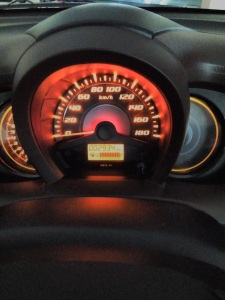
Took the Rajkot highway through the Ring road near to my home and after a continuous driving of 3.15 hours, it’s 7.00PM time, some 25 KMs away from Rajkot and we took a pit stop for fresh up and coffee for me and my better half, some ice creams for Kids and a good amount of rest of 30 min for Gajini.
After that pit stop, all 5 of us are charged now and with the help of few good traffic cops and Samaritans, were able to reach Rajkot-Jamnagar Bypass road. Voila, we are on Jamnagar road and passing by the Rajkot Cricket stadium. Heavy Police arrangement and stadium is glowing in full lights at the night. Kids enjoyed the scene and we are running fast.
It’s 9.00PM and we are in Jamnagar. Searched a bit and finally reached to the Hotel Deep Palace in Teen Batti area. Nice Hotel. Check in formalities are over and we are now in our room. Completed the dinner. Family demanded some cool stuff. Arranged the locally made Casata ice cream from Shri Ram Dairy ice cream. Nice yummy taste. A wide variety of Ice Cream is available . Family is now in rest mode and I’m discussing with Hotel staff for next day visit to Narara. I thank dear Suresh Ahaan from FB group AIFW for arranging the phone number of guide but some how, the fellow, did not pick my phone and now the hotel staff is arranging another one for me. It’s 10.30PM in the night, the guide came with another guide in tow and now we were handed over to the new fellow Mr. Ankur. I was ordered to be ready by 8-8.30AM in the morning for timely visit during low tide in Narara. It’s 11PM and now it’s the comfort of bed for me finally. Good night. Gajini is also happy to take REST. Total distance covered 322 Km. ‘Gazini’ specially liked the Rajkot – Jamnagar Highway in the night.
Day One – 18th October 2015:- It’s 6AM, I’m making things fast for each and every one. 7.30AM, each one of us is ready and wife dear is demanding some local hot and fresh breakfast. Order fulfilled and finally at 8AM, called the guide and he assured us to be ready in 10-15 min. Check out was done. Guide arrived and 8.30AM, Gajini, me and family are on road now. Guide is on his bike to park on highway. Reached that point and now guide is also with us.
Vroom… Vrom… We are on Jamnagar – Dwarka highway. There goes the world famous Reliance Refinery on our left side. There goes GSFC DAP plant on our Right. Now we are approaching Essar Refinery at Vadinar. It’s also time to fill the petrol tank. Done the same. It’s a right turn and now we are heading to Narara. 4KMs away from Narara, it’s last shop offering mineral water bottles and confectioneries. Guide advised us to purchase the same and we followed the advice. It’s 9.45AM and finally we are at Narara marine nature park, forest office. A permit is required for entry into the park – cost 500 Rs. For the group, camera charges 200 Rs. Extra. Total Rs. 700 Money paid and receipt of the same is received. It’s 10.15AM and we are now on our feet to sea shore. Possibly it’s the only marine nature park in India, where you can watch the following in their natural habitat away from the impact of HUMANs. Let the pictures do the talking.
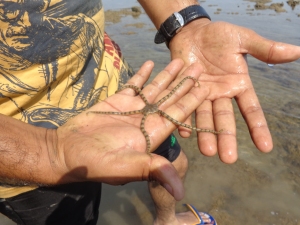

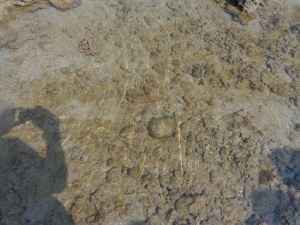
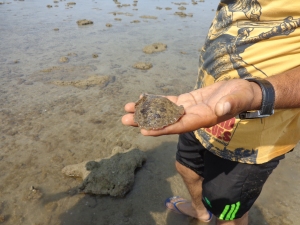



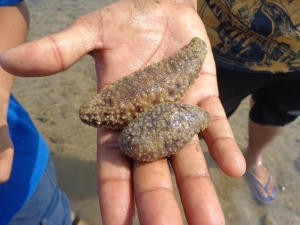
Daughter refused to walk down and hence she was continuously on my shoulders. After facing the harsh SUN for more than 1.30 Hours, even SON is now not interested and we are just pulling ourselves to the forest office for a shed and water. 12.30PM and finally we are back to forest office. A tiring yet satisfying experience. Back to Jamnagar – Dwarka Highway. Dropped the Guide on the junction point and paid him his fee of 1000 Rs. Now we are moving towards Dwarka. Now starts the problem. All are feeling hungry but not a decent eatery is coming on the way. Some how stopped on a petrol pump not for fuel but for a OK looking dhaba kind thing. Ordered kathiyawadi dishes, ringan to bhartho (Brinjal Bhartha), fulawar no shak (Cauliflower curry), Bataka nu shak (Potato cury), rotli (Gujarati chapatti) and Bajra no rotlo for food. Me and wife finished it. It was not what the kids prefer, hence some light snacks for them and we are back on road. Khambaliya is gone and now we are getting the view of Wind turbines. It’s indication we are approaching Dwarka.

It’s more and more Wind turbines and at last we are at Dwarka. The first hotel in the way – Hotel Krishna Inn and we are checking in. Time to take some rest as it’s 3.00PM. After a good amount of rest, all are now ready to have some food. Searched for a decent restaurant and landed into Charmi. Good one with a nice food, liked by all of us. Now we are back to hotel and after confirming the route, walking down to the DWARKADHEESH temple. A 10 min walk and we are at the temple. We are stopped at the security checking gate by the personnel there. Deposited the Camera, Mobile, Keys to the clock room. And now it’s darshan of Dwarkadheesh. Crowd is there inside the temple, still there is a calmness in the atmosphere. The temple is very old, yet we can imagine the past glory from the carvings on walls, pillars the over all structure.


After spending around 1 hour in the temple, now it’s time for some shopping from the nearby shops. Now we are back in the hotel and it’s time to say good night for a satisfying day. Total distance covered 182 Km.
Day Two – 19th October 2015:- It’s 7AM in the morning, all 4 of us are now getting ready to move on. It’s 8.30AM and finally we are checking out. Just at Nageshwar Temple cross road, hot and tasty breakfast of fresh Khaman and Palak (Spinach) Gota. Finally at 9.00AM, we are now moving to the Nageshwar temple – 19KM away from Dwarka, It’s one of the 12 Jyotirling. 9.30AM, we are at the Nageshwar temple. Paid the parking fee and straight to Temple. Again camera, mobiles, belts are not allowed. Not much crowd and peaceful darshan. The main attraction of this temple for my kids is below in the pictures.
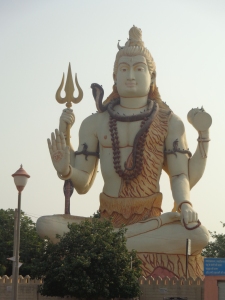
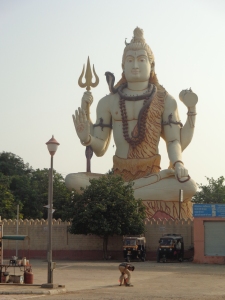
Now we are moving towards Gopi Talav. Reached there, paid the parking fee and going in. Kids and wife are delighted to see the floating stone of Ram setu fame in a temple.


Visited the Talav (pond) and now coming back. Time to drink some Coconut water. Now we are going to Okha Jetty for the final destination of Bet Dwarka in Dwarka region. On the way, crossed the Mithapur plant of Tata Chemicals for Soda Ash and other products.
While entering Okha, a lot of fishermen are busy in drying. Guess what? It’s FISH. A very hard pungent smell was there. Noticed only when the door was opened to ask for direction to Okha Jetty. We are at Jetty now. Boat ride and finally at Bet Dwarka. Visited the temple. We are late by few minutes and Priest pulled the curtains. Now we are waiting for 20 minute. 11.30 AM, now Dwarkadheesh is available for darshan. Temple restoration and repairing work is going on. Finally back to boating point, in between water bottle for all of us and ice creams as it’s a HARSH Sun on our heads.
Boatman is not ready to move till the boat is filled to brim. At last we are back to Okha Jetty and going back. Now it’s OKHA – Dwarka – Porbandar. More and more Wind turbines and finally we are in Porbandar. Asked for directions and in the market we find the way to Kirti Mandir. But before that, it’s time 2.30PM and a restaurant visit is necessary. Done it and finally we are at Kirti Mandir. Can not describe in words the calmness we felt there. Son is stunned with the historic photographs and facts mentioned there. It’s a great experience.
Now we are leaving to Somnath. Google and few good people’s help and we are on the coastal highway towards Somnath from inside the bylanes of Porbandar city. 1 Hour journey and we are at famous Madhavpur beach. A stop of 10-15 min. Wife and Son collected a lot of shells and now we are on our way. Crossed the Chorwad (birthplace of Dhirubhai Ambani). Except one Toran Gate, no major sign of Reliance or Dhirubhai’s legacy. Sunlight is fading fast and we are not in a mood to explore Chorwad. Crossed it and took a fuel stop at a petrol pump. Interestingly it’s raining Coconuts all around. It’s 7PM and finally we are in Somnath.
Checked in Lilavati Guest house’s Suite, run by Temple trust. A grand suite room with ample space and at a nominal cost of Rs. 1500 Per night. Took bath and now we are going straight to Temple. Once again it’s time to deposit, Camera, mobile, keys. Finally we are in the temple. Not much crowd and peaceful darshan of Shivling of Somnath. Got the opportunity to view Jalabhishek in the night. Pots after pots of water are poured in on the Shivling and what a delightful experience it’s it. No words for it to describe. It’s time to come out and rush to the nearest Restaurant for dinner. Ringan no Bhartho, Stuffed Masala Bhindi and Rotli for the adults. Veg. Hakka Noodles for prince of family and plain dosa for the princess.
Now we are back in the room and it’s time to say good bye but before that a change in plans. We are not going to Gir in the morning. Wife wants the evening time to be spent at the beach of Diu and hence tomorrow morning we ‘ll be going to Diu. Total distance covered 304 Km.
Day Three – 20th October 2015:- Wife dear is not happy with the night only darshan, so we are getting ready for morning darshan and specially the sea around the temple. 8.00AM and we are checking out and moving to temple. After the morning abhishek and sringar, the Shivling was looking very attractive. Alas. Cameras and pictures are not allowed. We are checking the Sea now, at the back of Temple. Time is to move out now but before that a Kesar Coconut drink for both of us and plain for Son. It’s 9.15AM and finally we are moving from Somnath to Diu. Once again it’s coastal highway. Somnath – Mangrol – Kodinar – Diu. It’s 11.00AM and we are finally in Diu. Reached the Pani Kotha Boating Point and checked in Hotel Relax Inn. Good hotel with a very good off season rate of Rs. 1500 Per night. Calm and clean Arabian sea is visible along with the Diu-Ghoghol Bridge from the Balcony.
Lunch time – done it in hotel Restaurant itself, located on the road just outside the hotel. Back in the room and after a bit of inquiry, we are now moving towards Fort. Inside the fort and after watching the old Guns and buildings, I can remember those old lines from a couplet –
Khandhar bata rahe hain Imarat buland thi.
A part of Fort is converted into sub division jail and hence out of bound but still it’s a large area to visit. Sun is shining with it’s full glory. We are now out of Fort. Time to drink the fresh juice of Sugar cane. Now we are going to the Church. An architect example of mixture of different styles.
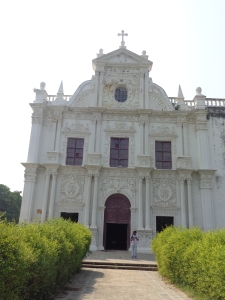
From Church to Diu Museum, Jalandhar Beach, sunset point, Chakratirth beach and finally we are at Naida caves. Let the pictures do the talking for these caves.

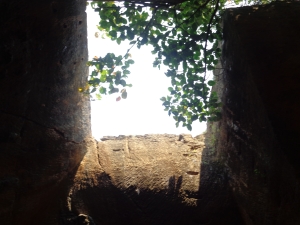
It’s 3PM and we are back into hotel for rest. After a good sleep, all of us are ready to go to Nagoa beach. The beach is clean but the water is not. It’s blackish and some what muddy. I opted out, Son and wife are still going in. After a while, the princess also wants to join the party and she is in the party with mommy and brother. Son wants to take the jet ski ride. Rs. 400 and here he goes for the same. A thrilling experience. It’s getting dark now and we are coming out. Few kid rides are available and the prince and princess are enjoying all of these. Now we are moving back to Hotel. After bath, it’s time to walk a bit and to go for the dinner on a beachside open restaurant. Regular stuff was ordered. Nothing special to write about. After the food, we are now in the Pani Kotha boating point area, Ice creams in hands and the cool sea breeze is blowing softly.
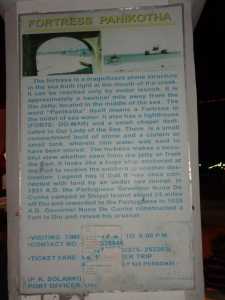
Finally we are back into hotel. Now is the time to plan for GIR. Two route options,
Option 1 – Diu – Kodinar – Prachi – Talala – Sasan (This means, returning and travelling back on last day’s route till Prachi on Coastal Highway)
Option 2 – Diu – Una – Khapat – Talala – Sasan (this means, going straight into GIR forest in patches)
I decided for option 2, for the thrill and adventure of Jungle driving. Total distance covered in the day. 106 Km.
Day Four – 21st October 2015:- It’s 7.00AM and we are getting ready. It’s 8.30AM and we are checking out finally and straight onto Diu-Una road. Diu is not a DRY (Alcohal) area but Gujarat is. The police men are asking for checking at the entry check post in Gujarat. No issue for me being Teetotaler. With the help of few good people on the way as well as google map, finally at 10.45AMwe are at SINH SADAN in SASAN, the forest office, from where the permits for Jungle safari are issued.
Anti Climax:- We are getting shocks after shocks. Here goes the list.
- No room available in the Govt. guest house.
- The morning Safari of 5AM and 9AM are already over and now only 3PM safari can be booked. That’s with only 23 permits in que (if I’m successful to sit within those lucky 23).
- There is no guarantee of meeting with the KING – the Asiatic lion, in that evening safari.
- Devaliya safari (12Km away from Sasan), in GIR Interpretation zone is over now for the morning at 11AM and we can not join even there. For evening it’s available.
- For boarding, we need to check into nearby lodges and guest houses.
It’s already 11AM and I’m telling the situation to my dear wife. The home minister ordered – Leave the Safari for some other day in future, we are leaving for Ahmadabad. But before that, it’s time to fill our empty tanks (stomachs). Just in front of the main gate of Sinh Sadan, a restaurant is offering Hot and crispy Aaloo (Potato) ka Parantha and Methi (Fenugreek) ka thepla. It’s parantha for me and son, thepla for the ladies of the family. In comes the Curd, the Lasan (Garlic) ni chatni and Mirch no athanu (Chilly pickle). A typical kathiawadi Brunch, we Munch. It’s 11.30AM and now we are leaving Sasan with a heavy heart and hope to come back some other day.

Now it’s a long drive. Sasan – Junagarh – Jetpur – Gondal – Rajkot – Ahmedabad.
Few Kms before Jetpur, the 4 lane toll road is there and Gajini is liking it again. A pit stop for fuel after crossing Rajkot and finally it’s home, sweet home in Ahmadabad at 5.45PM in the evening. Except that Post Rajkot pit stop for around 10 min, we did not take any stops and Gajini did not created any fuss. Handled all the workload superbly. Distance covered in the day 481 Km. Total distance covered in the trip from Home to home, 1395Km. Here comes the trip ending odometer Picture.

Now are you people eager to know about Gajini? My dear friends, here is our Gajini, Amazingly Indian.
Our Honda Amaze. Returned from the heavy workload and resting in the garage after taking a bath.




 Posted by ashalanshu
Posted by ashalanshu 





















